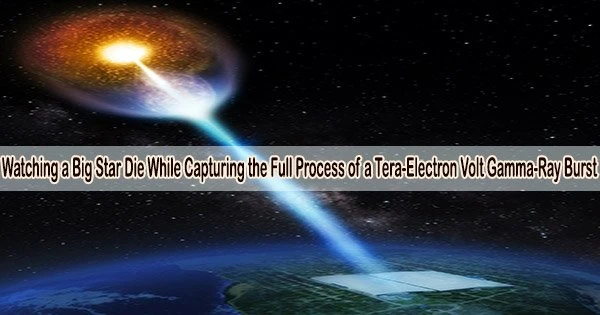A tera-electron volt (TeV) gamma-ray burst refers to a type of extremely high-energy astronomical phenomenon involving gamma-ray radiation with energy levels on the order of tera-electron volts.
Gamma-ray bursts (GRBs) are intense bursts of gamma-ray radiation, the most energetic form of electromagnetic radiation, which are often associated with the most violent events in the universe, such as the explosions of massive stars or the merging of compact objects like neutron stars or black holes.
New research findings on the gamma-ray burst (GRB) named GRB 221009A from the Large High Altitude Air Shower Observatory (LHAASO) were published online by the journal Science on June 8, 2023.
The study, titled “A tera-electron volt afterglow from a narrow jet in an extremely bright GRB 221009A,” was completed by the LHAASO international collaboration.
A gamma-ray burst (GRB), also known as a collimated burst of cosmic fireworks, was created about two billion years ago when a massive star that was more than 20 times as heavy as the sun ran out of fusion energy from its nuclear fuel and instantly collapsed and exploded.
The fireball collided with interstellar matter, producing high-energy gamma-ray photons that flew through the wide universe and were directed directly toward Earth. In the evening of October 9, 2022, at 13:20:50 UT, these photons reached the field of view of LHAASO, where over 60,000 gamma-ray photons were collected. After several months of analysis, scientists finally unveiled the details of this explosion event.
LHAASO precisely measures for the first time the entire light curve of high-energy photons from the afterglow of a GRB
The photon flux that LHAASO observed suggests that the photons originated from the radiation that followed the main burst. The initial, large explosion known as the prompt emission, which is characterized by intense low-energy gamma radiation, is the major burst. When the ejected matter collides with the surrounding interstellar gas at speeds very close to the speed of light, an afterglow a subsequent burst is created.
The observer happens to be directly facing the brightest core of the jet, and it naturally explains why this gamma-ray burst is the brightest in history and why such an event is so rare.
Professor Dai Zigao
“LHAASO accurately measured the complete process of the afterglow for the first time, comprising the entire phase of tera-electron volt gamma-ray flux from rise to decay,” said Cao Zhen, principal investigator of the LHAASO project, spokesperson for the LHAASO collaboration, and professor at the Institute of High Energy Physics (IHEP) of the Chinese Academy of Sciences.
Based on the observation of tens of thousands of GRBs, scientists have developed seemingly perfect theoretical models and have strong confidence in them. In order to accurately evaluate these theoretical models, LHAASO saw the entire high-energy light curve that previous experiments have not yet reached.
It is anticipated that this observed result will continue to be among the best for the foreseeable future for several decades or perhaps centuries given the rarity of this event, which most likely only happens once every millennium.
LHAASO measures for the first time the rapid enhancement process of high-energy photon flux from a GRB
“At the beginning of onset of the afterglow, LHAASO detected for the first time the extremely rapid enhancement of photon flux,” said Yao Zhiguo, a professor at IHEP and one of the corresponding authors of the paper.
The flux surged by a factor of more than 100 in less than two seconds, followed by a gradual rise consistent with an afterglow’s expected features. The early rapid enhancement phenomenon goes above and beyond what was predicted by earlier theoretical models.
This leads to a question: What mechanisms are actually at play. The results would lead to extensive arguments about the mechanisms underlying GRBs, such as energy injection, photon absorption, and particle acceleration, throughout the scientific community.
LHAASO unveils the mystery of the brightness of the brightest-of-all-time GRB
High-energy radiation begins to dim more quickly roughly 10 minutes after the afterglow begins, according to LHAASO measurements. “This can be explained by the fact that the ejected material after the explosion forms a jet-like structure, and the rapid decrease in brightness occurs when the radiation angle extends to the edge of the jet,” said Wang Xiangyu, a professor at Nanjing University and one of the corresponding authors of the paper.
The measured angle of the jet is estimated to be only 0.8 degrees due to the brightness transition’s incredibly early appearance. The brightest core of a typical internally bright and outwardly dark jet was seen, as this is the narrowest known jet angle to date.
“The observer happens to be directly facing the brightest core of the jet, and it naturally explains why this gamma-ray burst is the brightest in history and why such an event is so rare,” said Dai Zigao, a professor at the University of Science and Technology of China of CAS and one of the corresponding authors of the paper.
LHAASO’s data-intensive observations at high-energy will reveal more mysteries
Within the short duration of this event, the number of photons LHAASO recorded exceeded the cumulative number of photons observed from the “standard candle” Crab Nebula over the past few years.
“If the selection criteria were slightly relaxed, the photon count could even reach 100,000!” said Zha Min, a professor at IHEP and one of the corresponding authors of the paper.
Comparatively, other instruments in the same energy range have only been able to detect photons tens of seconds after the burst, and they have only found less than 1000 photons in other GRBs.
“As of now, there are still many unknowns in this burst event, and LHAASO scientists are still analyzing the data, in order to reveal more secrets. Please stay tuned for the subsequent analysis results from LHAASO,” said Prof. Cao.
















